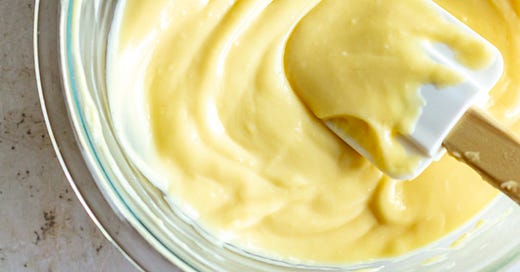A few weeks ago, I stumbled upon a reel that made my little pastry chef heart sad. It was a cute video from a fellow food blogger titled “my foolproof master pastry cream” and because it was from a creator with a fairly large following, it had a ton of views and likes and comments. The problem was, while the video was stunning and mesmerizing to watch, the pastry cream itself was riddled with curdled egg. It was lumpy and bumpy and every single chef I’ve ever met would have thrown it out and started over. It made me sad that so many people viewed this video and thought, that is what pastry cream is supposed to be like, simply because they have never seen it made before.
I don’t think that every food blogger needs to be a professional chef or have countless years of restaurant experience; however, I feel pretty passionately that recipe developers have a responsibility to be educated before educating others. When someone comes to my blog or newsletter and tries a recipe, they are investing their time and money in something because I’m telling them it will work. Of course, kitchens and equipment are different, and practice is an underrated necessity in the kitchen, but I believe that it’s important to know what you’re talking about before teaching it to someone else.
All of this to say, be discerning in your recipe searching. Do a little digging on the recipe writer and read their “about me” section—do they have some sort of culinary background, whether it be schooling or private cheffing or restaurant experience? If not, do they do their research? Is there evidence in a recipe post about why an ingredient is added or what an ingredient’s purpose is in a recipe? Read the comments—have people had success with the recipe? Does the recipe writer answer questions with knowledge and information? Keep in mind, stunning photos don’t always produce stunning recipes.
let’s learn how to make (clump-free) pastry cream
Pastry cream is a cornerstone of the pastry kitchen. It was one of the first things we had to learn how to make and we practiced it almost daily (throwing away many batches: see above) until it became second nature. In all of the pastry kitchens I’ve worked in, there has always been at least one dessert on the menu with a pastry cream component, meaning pastry cream production is a daily occurrence in the baker’s kitchen.
It’s versatile—pastry cream is the base for soufflés and pudding. It’s used to fill donuts or croissants or tarts. It’s folded into whipped cream to create diplomat creme, it can be used as a base for mousse, lightened with whipped cream and stabilized with gelatin. The possibilities are truly endless.
the basics
There are two main differences between pastry cream and créme anglaise (the second most popular custard in the pastry kitchen and next month’s deep dive topic)—starch and boiling.
Pastry cream has flour or cornstarch added to it and, therefore, must come to a boil in order to cook out that starchy flavor. Because of this, pastry cream is quite a bit thicker and more pudding-like than anglaise.
Keep reading with a 7-day free trial
Subscribe to Pastry School 101 to keep reading this post and get 7 days of free access to the full post archives.




